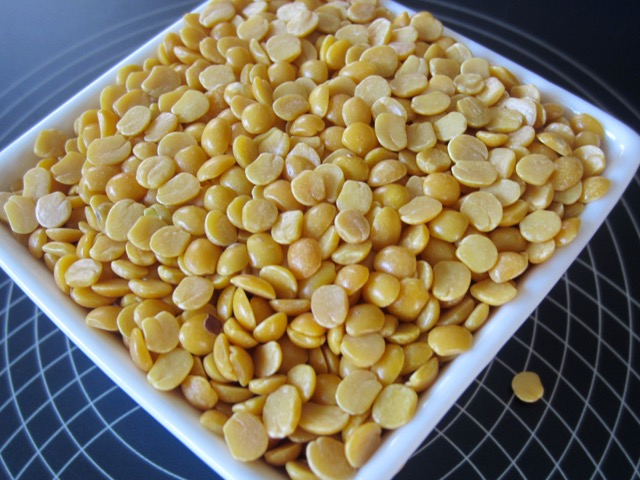Cajanus cajan (L.) Millsp.
Family: Papilionaceae, (Leguminosae)
Common Names: Toor dal,Togari bele, Congo pea, Angola Pea, Red gram, No-eye pea, tropical green pea, Gungo pea, Puerto Rico Pea; Pois cajanor or pois d’Angole (French)
Pigeon pea is a tropical leguminous shrub (Cajanus cajan). with trifoliate leaves, yellow to red flowers, and flattened pods that yield brown edible seeds, called pigeon peas. The seeds can be harvested while still green (like green peas) but they are mostly grown to maturity and then harvested, dried and sold, whole or split.
Split pigeon peas are produced by removing the brown seed coat from the dried seeds and then splitting the yellow cotyledon into two pieces. Once the seeds are split, they are very easy to confuse with split peas (Pisum sativum) or Split Desi chickpeas (channa dal), (Cicer arietinum).
Here is a photo of split and whole pigeon pea. The whole seeds are round to ellipsoid to squarish in shape, 4-9 x 3-8 x 3-6 mm and can be white, cream, brown, purplish to almost black in colour and plain or mottled. The brown seeds are marketed for consumption.
Where is Pigeon Pea Produced?
The main producer of pigeon pea is India, where it originated, and has been grown and consumed for thousands of years. Other major producers in Africa are, Malawi, Kenya, Tanzania and Uganda, where it’s also an important crop especially in the dry regions that don’t get heavy rainfall. It’s also grown in the rest of sub-Saharan Africa and in Canada and France.
Nutrition of Split Pigeon Peas
Pigeon peas contain three essential amino acids, methionine, lysine and tryptophan. 100g (3.5oz) Split Pigeon Pea provides 330 calories and contains the following:
Fat: 2g (saturated 0.5g)
Cholesterol: 0g
Sodium: 15mg
Carbohydrate:64g (sugar 4g, Fibre 10g)
Protein: 20g
Recommended Daily Allowance. (RDA)
Minerals: Iron (20%) and Calcium (2%); Vitamins: A (0%); C (0%) Source: my package
Use of Split Pigeon Peas
Split pigeon pea (Toor dal) is popular in India for making ‘dhal’ or ‘Dal’ and for making a spice blend called ‘Sambhars.’
In Africa, the dried seeds are used to make sauces served with accompanying staple foods like cassava, ugali, plantain or sweet potato.
In Asia, pigeon peas may be used instead of soya bean to make tempeh or tofu and the seeds can also be sprouted.
Toor dal (split pigeon pea) can be cooked together with rice as seen below.

Below are photos of split pigeon pea (Cajanus cajun), split chickpea (Cicer arietinum, Chana dal) and split dried yellow pea (Pisum sativum, Matar Dal).

myfavouritepastime.com Last Updated: July, 15 2019


